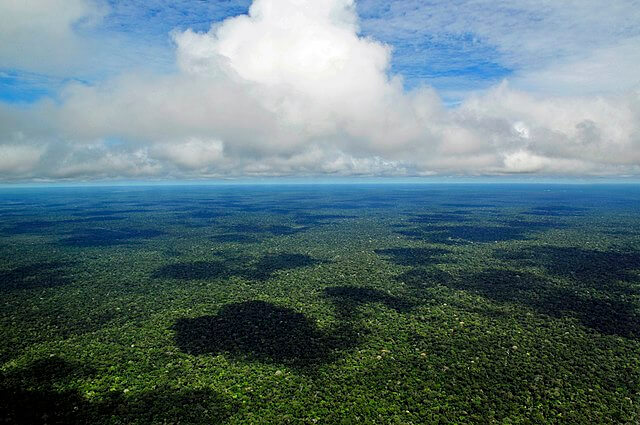
In 2023, the Amazon rainforest faced an unprecedented drought, marking its worst on record.
The ramifications have been profound, rendering many villages inaccessible by river, triggering wildfires, and causing significant wildlife casualties.
For scientists, these events serve as ominous indicators that the world’s largest forest is hurtling towards a critical juncture with potentially irreversible consequences.
The customary rainy season in the Amazon, expected to commence in October, persisted in dry and hot conditions until late November. This aberration is attributed to the cyclical El Niño weather pattern, intensified by the overarching influence of climate change.
El Niño elevates Pacific Ocean temperatures, propelling heated air over the Americas. This year, abnormal warmth in the North Atlantic compounded the situation, enveloping the Amazon in hot, arid air.
“When it was my first drought I thought, ‘Wow, this is awful. How can this happen to the rainforest?'” says Flávia Costa, a plant ecologist at the National Institute for Amazonian Research, who has been living and working in the rainforest for 26 years.
“And then, year after year, it was record-breaking. Each drought was stronger than before.”
She says it’s too soon to assess how much damage this year’s drought has done, but her team has found many plants “showing signs of being dead”.
Past dry seasons offer insights into the potential harm that could unfold. The 2015 “Godzilla drought” alone reportedly claimed 2.5 billion trees and plants in a specific region of the forest, and this recent drought surpasses its severity.
“On average, the Amazon stopped functioning as a carbon sink,” Dr Costa says. “And we mostly expect the same now, which is sad.”
Beyond its stunning biodiversity, the Amazon is a repository of approximately 150 billion tonnes of carbon. Many scientists express concerns that the forest is hurtling towards a theoretical tipping point—a juncture where it dries up, fragments, and transforms into a savannah.
The Amazon currently sustains its own weather system. Within this expansive rainforest, water evaporates from trees, forming rain clouds that traverse the canopy, recycling moisture multiple times. This process keeps the forest cool and hydrated, facilitating the sustenance of life.
However, if significant portions of the forest perish, this mechanism could rupture, leading to potentially irreversible consequences. Brazilian climatologist Carlos Nobre introduced this theory in 2018, suggesting that if 25% of the Amazon is deforested and global temperatures rise to 2-2.5°C above pre-industrial levels, the tipping point could be reached.
“I’m even more worried now than I was in 2018,” he says. “I just came back from COP28 and I’m not optimistic that greenhouse gases will be reduced by the agreement targets. If we exceed 2.5C, the risks to the Amazon are horrendous.”
Presently, 17% of the Amazon has succumbed to deforestation, and global temperatures hover around 1.1-1.2°C above pre-industrial levels. Dr. Nobre finds some optimism in the fact that deforestation rates reduced across all Amazon countries this year, with commitments to achieve zero deforestation by 2030. He believes Brazil can reach this target even sooner.
While not all scientists align with Dr. Nobre’s belief in a complete transformation of the forest, signs of degradation are pervasive. Wildfires, typically confined to already degraded areas, spread to untouched primary forests this year.
Additionally, alarming ecological distress is evident, with hundreds of dolphins found dead in lakes, possibly due to elevated water temperatures reaching nearly 4°C above the norm.
“It was just devastating,” says Dr Miriam Marmontel, from the Mamirauá Institute for Sustainable Development. “We were dealing with live animals, beautiful specimens and then five days later, we had 70 carcasses.”
In a matter of weeks they found 276 dead dolphins. Dr Marmontel believes it’s the temperature of the water that is killing them. It reached 40.9C in places, nearly 4C higher than dolphin body temperature.
“You can imagine, the animal that has its whole body immersed in that water for so many hours,” Dr Marmontel says. “What do you do? That’s where you live, then all of a sudden, you’re in the middle of this soup and you can’t get away.”
In the heart of the Amazon, the city of Coari experienced dense smoke as a result of uncontrolled fires, often ignited for land clearance. Dr. Flávia Costa’s research suggests that while some parts of the forest may survive, those with easy access to groundwater, such as valleys, could be more resilient.
Dr. Marmontel, who has spent 30 years in the Amazon, expresses shock at witnessing the region undergo such rapid climatic changes.
“It was like a slap in the face. Because it’s the first time that I see and I feel what’s happening to the Amazon,” she says.
We always say these animals are sentinels because they feel first what’s going to come to us. It’s happening to them, it’s going to happen to us.”
The urgency to address these challenges has never been more apparent as the Amazon grapples with a fragile balance, teetering on the brink of potential transformation and irreversible ecological consequences.
——————————————————————————
At Natural World Fund, we are passionate about stopping the decline in our wildlife.
The decline in our wildlife is shocking and frightening. Without much more support, many of the animals we know and love will continue in their decline towards extinction.
When you help to restore a patch of degraded land through rewilding to forests, meadows, or wetlands, you have a massive impact on the biodiversity at a local level. You give animals a home and food that they otherwise would not have had, and it has a positive snowball effect on the food chain.
We are convinced that this is much better for the UK than growing lots of fast-growing coniferous trees, solely to remove carbon, that don’t actually help our animals to thrive.
This is why we stand for restoring nature in the UK through responsible rewilding. For us, it is the right thing to do. Let’s do what’s right for nature!
Donate today at https://naturalworldfund.com/ and join in the solution!

